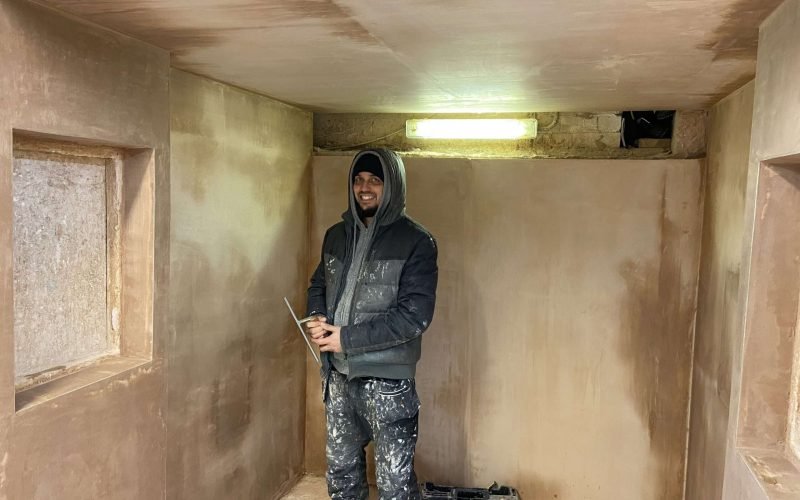A Comprehensive Guide to Mastering Plastering Abilities for Your Remodelling Requirements

Vital Tools and Products
Different necessary devices serve distinct functions, making certain effectiveness and accuracy throughout the plastering procedure. A top notch trowel, for instance, is essential for smoothing and using plaster, while a hawk gives a secure system for holding the material.
In enhancement to tools, selecting the right plastering materials is vital. Gypsum-based plasters are typically preferred for their adaptability and simplicity of usage, while cement-based options are ideal for exterior applications as a result of their resilience. Water and bonding agents play substantial functions in achieving appropriate consistency and bond, ensuring that the plaster sticks properly to the surface.
Furthermore, protective gear such as gloves, masks, and safety glasses is essential to secure versus dust and irritability during the application procedure. By putting together the appropriate combination of materials and devices, plasterers can boost their ability and generate top quality surfaces, inevitably raising the overall craftsmanship of their job.
Preparing Surfaces for Gluing
Attaining a durable and smooth plaster coating begins with thorough prep work of the surfaces to be plastered. This fundamental action is important to ensuring attachment and the durability of the plaster. Start by evaluating the problem of the substratum-- whether it is drywall, concrete, or masonry-- getting rid of any kind of loose paint, dirt, or particles that might conflict with bonding.
Following, fix any type of blemishes such as fractures or holes. Use an appropriate filler to accomplish a degree surface area; this can be crucial for stopping future concerns. Once fixed, guarantee the surface area is tidy and completely dry, as wetness can compromise plaster adherence.
For permeable surface areas, it is recommended to use a bonding agent. This item improves bond and develops a reputable interface between the plaster and substratum. If functioning with formerly plastered surface areas, it might be needed to scuff or sand the location gently to give a secret for the brand-new plaster layer.
Smudging Strategies and Tips
Mastering gluing techniques calls for both ability and technique to achieve a flawless surface. One essential strategy is the application of the plaster in numerous thin layers, instead of a single thick coat. This method permits far better attachment and decreases the threat of fracturing. Beginning with a skim coat, guaranteeing it is uniformly spread and leveled with a hawk and trowel. Utilize a straightedge to look for any kind of imperfections prior to going on to succeeding layers.
When applying the finish coat, use a shoveling strategy that entails holding the trowel at a minor angle and operating in a round motion. This helps to develop a smooth surface area and lowers the look of trowel marks. Furthermore, maintain a spray container of water handy to mist the surface gently; this keeps the plaster convenient and permits smoother finishing.
Timing is essential; job redirected here effectively, as the plaster begins to set. As soon as the plaster has firmed up yet is still moist, utilize a moist sponge to gently smooth the surface area additionally. Finally, enable adequate drying time prior to sanding or paint, guaranteeing your tough work causes an expert, premium coating.
Typical Errors to Prevent

An additional usual mistake is applying plaster as well thickly. Overzealous applications can bring about breaking and extended drying times. It's vital you could try these out to apply plaster in thin, also layers, allowing each coat to dry adequately prior to including more.
Furthermore, not using the right devices can prevent the high quality of the coating. Making use of unsuitable trowels or mixers can create incongruities in the smudging procedure. Constantly choose high-quality tools developed for plastering tasks.
Last but not least, many individuals undervalue the significance of timing. Working in unsuitable temperatures or moisture degrees can adversely influence plaster treating and drying out. It is a good idea to examine weather and adapt your timetable appropriately.
Finishing Touches for an Expert Look
The last phases of a gluing job are important for achieving a polished, specialist appearance. As soon as the plaster has dried out adequately, the next step is to assess the surface for flaws. Minor bumps, holes, or irregular areas should be addressed making use of fine sandpaper or a fining sand block. This meticulous interest to detail is necessary for making sure a smooth finish.
After fining sand, it's suggested to cleanse the surface to get rid of any kind of dust and debris. A moist fabric works for this function, adhered to by a complete drying out duration. If required, applying a slim layer of completing plaster can improve the surface area even more, providing a smooth finish.
Once the finishing plaster is completely dry, another round of fining sand might be called for to accomplish the preferred level of smoothness. click now Finally, consider using a guide before painting or wallpapering, which will certainly boost adhesion and toughness.
Conclusion
Mastering smudging abilities substantially enhances the quality of improvement projects. A complete understanding of vital devices, surface prep work, and reliable techniques is critical for accomplishing expert results. Understanding of common mistakes permits for the avoidance of expensive errors, while interest to ending up touches ensures a sleek look. Eventually, the assimilation of these aspects contributes to the development of smooth, sturdy surfaces that boost the visual worth of any area, highlighting the significance of experienced plastering in home improvement ventures.
Water and bonding agents play significant functions in accomplishing appropriate uniformity and bond, making sure that the plaster sticks successfully to the surface. Plastering.


In addition, maintain a spray bottle of water useful to mist the surface area gently; this keeps the plaster workable and allows for smoother completing. (Plastering)
If required, applying a slim layer of completing plaster can enhance the surface area additionally, giving a smooth surface.
Comments on “Residential Plastering: Change Your Home with Competent Craftsmanship”